A new variant of SARS-Cov2 was first identified in South Africa and is already spreading
AT A GLANCE
- A new variant of SARS-Cov2 was first identified in South Africa and is already spreading
- The news prompted immediate travel restrictions. Risk assets tumbled Friday while, safe havens rose.
- It’s simply too early to assess the investment implications of Omicron. We keep our positioning for now.
“No doubt, the most important single driver of the current economic outlook remains the pandemic”: the first sentence of our weekly publication last Sunday was more timely than we thought. The new variant Omicron was named a “variant of concern” by the WHO on Friday. Early data suggest it may spread rapidly, due to a very high number of mutations which may limit the efficacy of current vaccines. However, we don’t know much more yet, including its virulence which is obviously crucial to assess whether the economy will be harmed again by lockdowns, or not. Countries have been quick to restrict travels from South Africa where it first emerged. Markets were even quicker. Global stocks lost more than -2% on Friday, and prices of oil tumbled to $72 for the Brent. Gold resisted and safe bonds were buoyed with the US 10-year Treasury yield losing an impressive 16 basis points to 1.47%. 2022 Fed rate hikes also almost evaporated from market-implied forecast.
The new variant is a concern. But volatility is not a surprise, as we write for months. Instant reactions are usually wrong, and we do not have enough data to form a new view. Our scenario has always been that we now live with the virus, not that we eradicate it. The worst-case scenario is that this variant is both highly contagious and highly virulent: this would impact the short-term outlook but also prolong support and trigger stronger responses. Investment implications are thus unclear, especially after Friday’s material move. The “risk-off” episode may even be a buying opportunity, depending on how data evolve, especially for the most affected assets – among which potentially our regional markets. We will closely monitor the situation and hopefully have more input for our asset allocation committee on December 7th. Stay safe.

Cross-asset Update
The flight to quality witnessed last week across asset classes is reminiscent of the early days of the pandemic, when little was known about the virus and no remedy was at hand to fight it, other than lockdowns and other precautionary measures. Yet, a lot of progress has been made ever since, and we have already seen the playbook of restrictions being implemented following different virus variants, with subsequent waves being more infectious, but less deadly than the previous ones. So, if recent history is any guide, the market reaction should be temporary. With equity valuations high and investor sentiment bullish a shake-out could take place, a deeper retracement in the major indices which has failed to materialize year to date. Amongst non-traditional assets, bitcoin was no exception and recorded losses in the high-single digits as panic spread, countering the notion of it being able to play the role of a safe haven if need be. We repeatedly expressed doubts about that kind of bitcoin-good-for-everything view. Quite to the contrary, the yearly returns of the cryptocurrency tend to track global market sentiment, hence bitcoin is a cyclical macro asset, and as such cannot even offer great protection against runaway inflation. Gold, on the other hand, on Friday staged a mild rebound, as real rates tumbled.
And this takes us to our view that markets had priced in too much of central bank tightening, pricing which was partially undone following the news of the new virus variant on Friday. Pandemic twist and turns apart, we still think that the hurdle for the Fed to embark on a steep tightening cycle in 2022 is pretty high. Will the Fed dare tighten before the November mid-term elections, and even worse, stand in the way of the Biden spending bill aimed at supporting longer-term growth? Will the Fed hike so much as to eventually trigger a recession and undo mammoth monetary and fiscal efforts, to restart from scratch and then, what? Will the Fed raise the cost of money and make that of servicing government debt more onerous, if not unsustainable? In short, the political and economic costs of a steeply tighter policy are so big, that the Fed will stay put or just implement a token hike next year. Even though real policy rates are close to record-negative lows, rates will be capped to maintain real yields in negative territory, and reduce the real cost of debt without cutting it down.
In turn, negative real yields for a prolonged period of time would continue to make equities more appealing than government bonds, bring gold to the fore against currency debasement and usher in a bear market for the US dollar. But for now, a higher dollar will serve the Fed’s purpose of moderating inflationary pressures, gold will be treading water until it is clear that the Fed won’t be doing much after all, while equities remain the asset class of choice, virus-induced volatility notwithstanding.
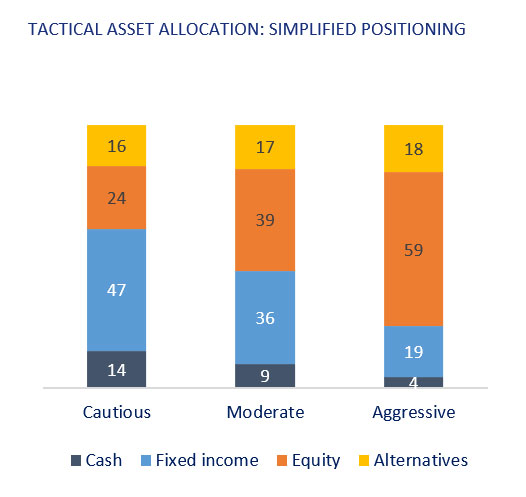
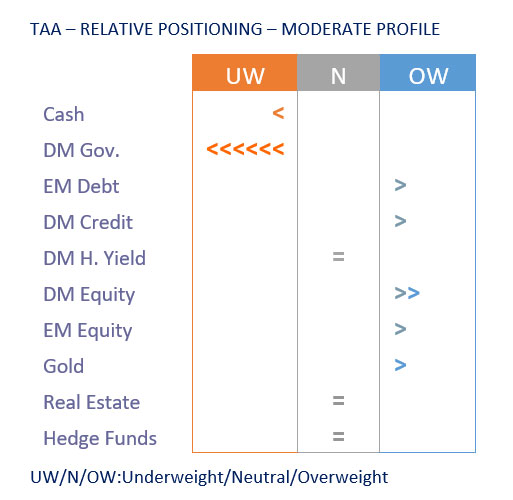
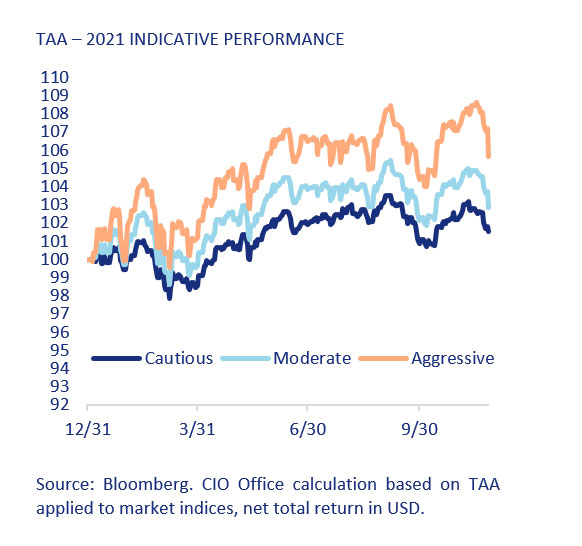
Fixed Income Update
Strategists continuously talk about the benefits of diversification. But only during market turbulence do we really appreciate the value of well-diversified episodes. Last week after the new Covid-19 variant clobbered the risky assets, including the credit products within Fixed income such as EM Debt and High Yield, investors found out that US Treasury and Investment Grade exposures were the only asset classes that protected their portfolios. The two assets provided positive weekly returns of 0.9% and 0.3%, respectively. In our regular communication, we have also been touting the benefits of China's local Currency IG debt since May 2021. The asset class was flat, with spreads hardly widening. Most investors who have chased yield would not have enough exposure to any of the above three segments and would have High Yield and EM Debt in their portfolios which have lost -1.1% and -0.7% last week, according to Bloomberg Barclays indices. The OAS spreads of both the asset classes widened by 40 and 22 bps, respectively wiping out the effect of a significant Bull-flattening in the US Treasury yield curve. The 10-year US Treasury yield lost 16 bps in a single day, the largest daily movement post-March 2020.
2022 is going to be a year of many possibilities and few convictions. Under such a scenario, including a little bit of everything in the fixed income portfolio is the best course of action. If the growth story remains on course and inflation runs red, then HY and EM Debt exposure would give the much-needed yield. At the same time, in case of black swan events, the three asset classes US Treasury, developed market IG debt, and Chinese Government Bonds, would likely put a floor on the portfolio losses.
It is still early days for the new variant, and it may be "much ado about nothing." But markets have reacted in a risk-off manner to push back rate hike bets. We should get more clarity in the coming weeks, but most analysts agree that this wave might not be as severe as the previous delta wave due to the rise in the level of vaccinations. Only the countries that lag in vaccination and the reopening trade sectors should be impacted. We believe there could be opportunities for dip-buying at elevated spread levels. Global High Yield and EM Debt currently trade around 28 and 50 bps wider than where they started the year. We would be looking to buy if spreads widened by another 25 bps from current levels in either of the segments. High Yield defaults continue to be lower, with the segment having issued a record $455 Bn of bonds this year to push back maturity and short-term debt levels. Emerging Market sovereigns have received significant support from IMF and other organizations. We do not think credit risk would rise significantly from current levels even if we go through localized lockdowns.
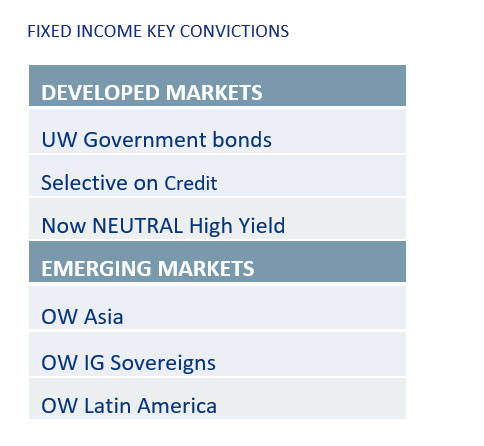
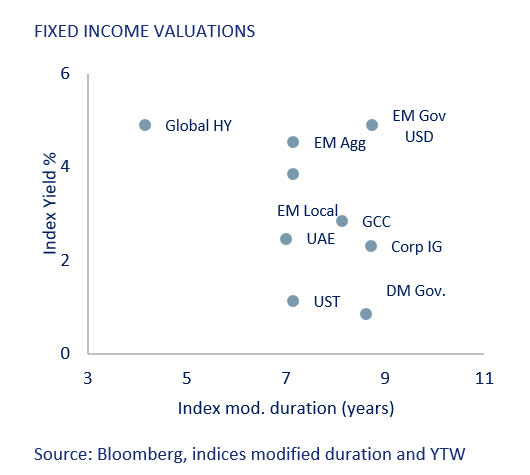
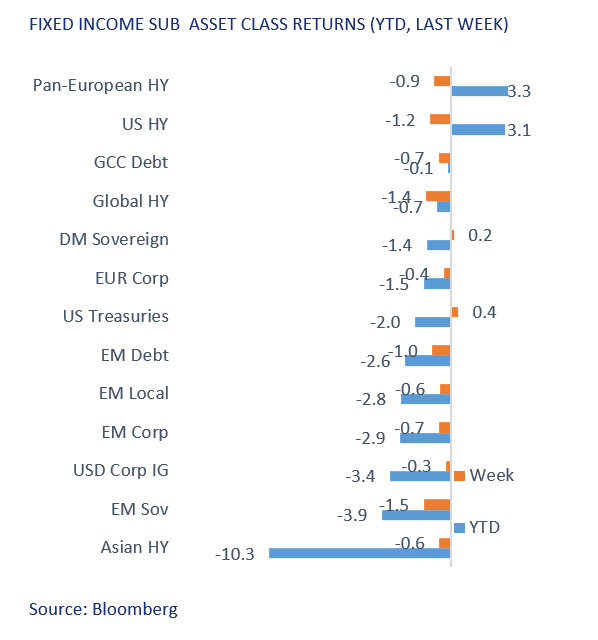
Equity Update
The new COVID variant “Omicron”, with a number of cases recorded in South Africa, led to a wave of caution through global markets on Friday as concerns around the economic impact of the new travel restrictions and lockdowns rose. Global stocks fell -2.2%, a broad based geographic sell off, with the MSCI Asia Pacific Index -1.7%, the European Stoxx 600 -3.7% and the U.S. S&P 500 -2.3%, the last on a shortened day of trading. A sudden recalibration for markets that had been focused on inflation and monetary tightening, Friday saw US Treasuries gain and markets are now anticipating that the Fed will keep interest rates lower for longer. GCC markets (closed on Friday) had a mixed week with Dubai and KSA indices falling and Abu Dhabi gaining. We expect GCC equities, +39% YTD to react to a lower oil price. Oil fell on reduced mobility concerns with Brent trading down 11.5%.
Global equities followed a familiar Covid-era pattern and stay at home winners such as video conferencing companies Zoom, streaming and gaming companies and vaccine-makers Moderna and Pfizer rallied while reopening sectors i.e. airlines, leisure and online booking sites fell. All global sectors were in the red with energy the worst off and healthcare the least affected. The market drop was a reminder that Covid is still a powerful force for markets, and likely to drive sharper market action than inflation in the short term. Investors are worried about increasing lockdowns and uncertainty over how effective the vaccines will be, though mRNA vaccine makers such as Moderna are conducting clinical trials of booster candidates, and BioN Tech, Astra Zeneca and J&J are testing the efficacy of their vaccines against the new variant. It is premature to consider Friday’s slide a change in trends. The new variant is concerning, but it will create prolonged market jitters only if it evades the protection of vaccines and therapies. The economic fallout of the new variant should be contained as the world is better equipped with higher immunity, booster shots and antiviral drugs.
Many equity markets, barring China and Latin America, indices were at record highs a week ago, post very strong Q3 earnings and strong inflows with the higher valuations starting to be worrying,. Global stocks are up 15.5% year to date, the S&P 500 +24%. A 5 to 10% move down, seen usually once or twice a year, is a norm in markets, but not seen this past year. Last week we spoke of the three headwinds to markets- rising COVID infections, inflation and monetary policy tightening. The first now takes centre stage. Inflation has largely been demand driven and also a result of supply chain constraints, which had recently begun abating. Interest rate hike expectations are already taking a breather. We remain constructive on market returns but expect continued volatility. Many positives still in play – ample liquidity with record savings supporting consumption and a low interest rate environment. U.S. and U.K. Black Friday online sales beat expectations. In emerging markets, the India economic recovery has been rapid with strong consumer demand reflected in the +20% gains in equities, though China performance is lagging as it focuses on reducing dependence on monopolistic payment systems and data security and China listed firms in the U.S. such as Didi which have large user data bases have been told to delist from U.S. exchanges.
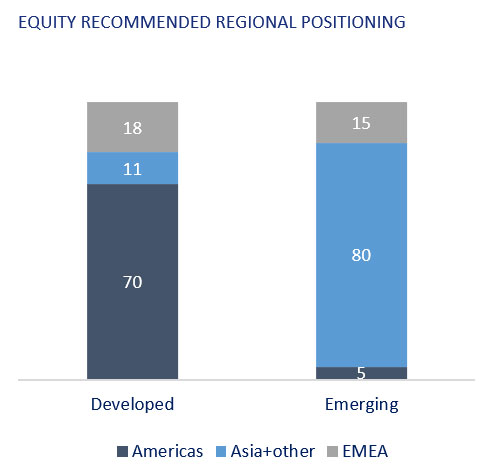

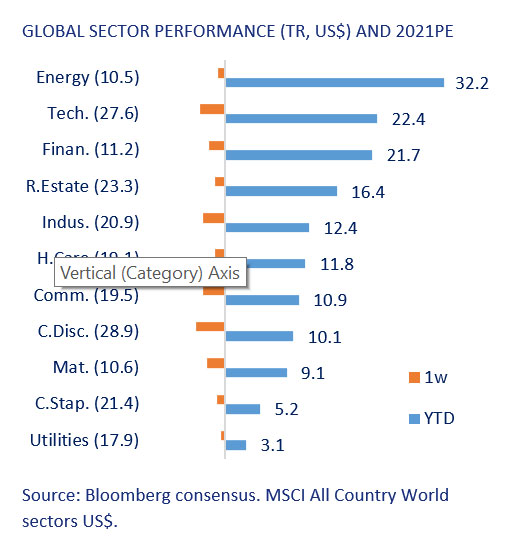
إخلاء مسؤولية
الموثوقية
يبذل بنك الإمارات دبي الوطني ش.م.ع ("الإمارات دبي الوطني") ما بوسعه للحصول على معلومات من مصادر يعتقد أنها موثوقة. ومع ذلك، لا يقدم بنك الإمارات دبي الوطني أي إقرار بأن المعلومات أو الآراء الواردة في هذه النشرة دقيقة أو موثوقة أو كاملة، كما أنه لا يمكن الاعتماد أو التصرف بناءً عليها دون مزيد من البحث والتحقق. الآراء والتقديرات والأحكام الواردة هنا هي آراء الكاتب وقد تخضع للتغيير دون إشعار. لا يتحمل بنك الإمارات دبي الوطني أي مسؤولية من أي نوع عن أي خسارة أو ضرر ناتج عن أي فعل أو قرار خاطئ يتم اتخاذه نتيجة للمعلومات الواردة في هذه النشرة. البيانات/ المعلومات الواردة هنا هي لأغراض توضيحية وليست مصممة لبدء أو إبرام أي معاملة. بالإضافة إلى ذلك، أعدت هذه النشرة في تاريخ ووقت محددين وهي لا تعكس التغييرات اللاحقة في السوق أو التغييرات في أي عوامل أخرى ذات صلة بتحديد ما إذا كان نشاط استثماري ما مناسباً أو لا. قد تتضمن هذه النشرة بيانات/ معلومات من أسواق الأوراق المالية ومصادر أخرى من جميع أنحاء العالم ولا يضمن بنك الإمارات دبي الوطني التسلسل أو الدقة أو الاكتمال أو التوقيت الذي تقدمه أطراف أخرى غير التابعة. علاوة على ذلك، يخضع توفير بعض البيانات/ المعلومات الواردة في هذه النشرة لشروط وأحكام الاتفاقيات الأخرى التي يعتبر بنك الإمارات دبي الوطني طرفاً فيها. يجب على أي شخص يرغب في الاعتماد على المعلومات الواردة في هذه النشرة أو استخدامها أن يتحقق ويتأكد وبشكل مستقل من دقة المعلومات واكتمالها وموثوقيتها ومدى ملاءمتها، ويجب أن يحصل على استشارة مستقلة ومحددة من قبل أحد المختصّين أو الخبراء المناسبين. علاوة على ذلك، لا تعني الإشارة إلى أي أداة مالية أو منتج استثماري، وجود سوق تداول فعلي لهذه الأداة أو المنتج. يتم توفير المعلومات والآراء الواردة في نشرات بنك الإمارات دبي الوطني للاستخدام الشخصي ولأغراض إعلامية فقط وهي خاضعة للتغيير دون إشعار. إن المواد والمعلومات الموجودة في هذه النشرة هي لغرض التداول العام فقط، ولم نأخذ في عين الاعتبار عند إعدادها الأهداف والوضع المالي والاحتياجات الخاصة لأي شخص محدّد، في أي مكان.
السرية
يتم تقديم هذه النشرة لكم عند الطلب على أساس السرية لأغراض إعلامية فقط وهي لا تخدم أي أغراض تجارية وليست معدّة ليتم تقديمها أو الكشف عنها لأي شخص آخر و/ أو إلى أي ولاية قضائية من شأنها أن تجعل التوزيع غير قانوني. لا يجوز للمستثمر عرض أي جزء من هذه النشرة للبيع أو توزيعها عبر أي وسيلة بما في ذلك، على سبيل المثال لا الحصر، البث التلفزيوني أو الإذاعي عبر الراديو أو شبكات الكومبيوتر أو الإنترنت، أو إنشاء قاعدة بيانات من أي نوع دون الحصول على موافقة خطية مسبقة من بنك الإمارات دبي الوطني.
التوصية
لا يمكن اعتبار أي محتوى في هذه النشرة طلباً أو عرضاً أو رأياً أو توصية من بنك الإمارات دبي الوطني لشراء أي ورقة مالية أو بيعها، أو لتقديم مشورة أو خدمات قانونية أو ضريبية أو محاسبية أو استثمارية فيما يتعلق بربحية أو ملاءمة أي ورقة مالية أو استثمار. كما أنها لا تقدم أي مشورة ائتمانية أو مالية.
الأطراف الأخرى
قد لا يكون الضمان أو الاستثمار المذكور في هذه النشرة مؤهلاً للبيع أو الاشتراك ضمن فئات معينة من المستثمرين. هذه النشرة غير مخصصة للاستخدام من قبل أي شخص أو التوزيع إلى أي شخص أو كيان في أي ولاية قضائية أو بلد حيث سيعتبر هذا الاستخدام أو التوزيع مخالفاً للقوانين واللوائح. تقع على عاتق أي شخص يمتلك هذه النشرة مسؤولية التحقيق ومراعاة جميع القوانين واللوائح المعمول بها في الولاية القضائية ذات الصلة. لا يجوز نقل هذه النشرة أو استخدامها من قبل طرف ثالث دون الحصول على موافقة صريحة من بنك الإمارات دبي الوطني. لا يجوز للمستثمر استخدام البيانات الواردة في هذه النشرة بأي طريقة لتحسين جودة أي بيانات يتم بيعها أو تقديمها إلى أي طرف ثالث.
المسؤولية القانونية
في حال وجود ما يتعارض مع ما هو منصوص عليه في هذه الاتفاقية، فلا يتحمّل بنك الإمارات دبي الوطني أو موردوه أو وكلاؤه أو مديروه أو المسؤولون فيه أو موظفوه أو ممثلوه أو خلفاؤه أو المتنازل لهم أو الشركات التابعة أو الكيانات التابعة المسؤولية، بأي شكل من الأشكال، تجاهك أو تجاه أي شخص آخر بسبب: (أ) عدم الدقة أو الأخطاء أو الحذف من هذه النشرة بما في ذلك، على سبيل المثال لا الحصر، عروض الأسعار والبيانات المالية؛ أو (ب) الخسارة أو الضرر الناشئ عن استخدام هذه النشرة، بما في ذلك على سبيل المثال لا الحصر، أي قرار استثماري ناتج عن ذلك. كما لن يكون بنك الإمارات دبي الوطني أو موردوه أو وكلاؤه أو مديروه أو المسؤولون فيه أو موظفوه أو ممثلوه أو خلفاؤه أو المتنازل لهم أو الشركات التابعة أو الكيانات التابعة، تحت أي ظرف من الظروف، بما في ذلك على سبيل المثال دون حصر الإهمال، مسؤولين تجاهك عن الأضرار المباشرة أو غير المباشرة أو العرضية أو التبعية أو الخاصة أو المادية أو المعنوية حتى لو تم إخطار بنك الإمارات دبي الوطني على وجه التحديد بإمكانية حدوث مثل هذه الأضرار الناشئة عن استخدام هذه النشرة، بما في ذلك على سبيل المثال لا الحصر، خسارة الإيرادات أو الفرص أو الأرباح المتوقعة أو خسارة العمل.
لا تقدّم هذه النشرة استشارة استثمارية مصممة بشكل فردي كما يتمّ إعدادها بغض النظر عن الظروف المالية الفردية وأهداف الشخص الذي يتسلّمها. تعتمد ملاءمة أي نشاط أو استراتيجية استثمارية على الظروف والأهداف الفردية للشخص وقد لا تكون هذه الأنشطة مناسبة لجميع الأشخاص. بالإضافة إلى ذلك، قبل الشروع في أي معاملة، يجب أن تكون المخاطر مفهومة تماماً وأن يتم تحديد ما إذا كانت المعاملة مناسبة بناءً على الأهداف الاستثمارية للشخص، والموارد المالية والتشغيلية والخبرات والظروف الأخرى ذات الصلة. يجب معرفة جميع الالتزامات المتعلقة بمعاملة معينة (والعلاقة التعاقدية) بما في ذلك، على سبيل المثال لا الحصر، طبيعة ومدى التعرّض للمخاطر وكذلك أي متطلبات وقيود تنظيمية مطبّقة عليها.
النظرة المستقبلية
لا يعتبر الأداء السابق بالضرورة دليلاً على الأداء المستقبلي ولا ينبغي اعتباره مؤشراً على الأداء المستقبلي لأي نشاط استثماري. لا تنصّ المعلومات الواردة في هذه النشرة على أنها تحتوي على جميع المواضيع ذات الصلة بأي استثمار أو أداة مالية معينة، ولا يتم ضمان دقّة جميع البيانات المتعلقة بالأمور المستقبلية. تشكّل بعض المواضيع الواردة في هذه النشرة والمتعلّقة بالأداء المستقبلي لبنك الإمارات دبي الوطني أو أعضاء مجموعته (المجموعة)، بما في ذلك على سبيل المثال لا الحصر، الإيرادات المستقبلية والأرباح والاستراتيجيات والآفاق وجميع البيانات الأخرى غير التاريخية في الأساس، "بيانات تطلعية ". تستند هذه البيانات التطلعية إلى التوقعات أو المعتقدات الحالية، بالإضافة إلى الافتراضات حول الأحداث المستقبلية المكوّنة من المعلومات المتاحة حالياً. غالباً ما تستخدم البيانات التطلعية كلمات مثل "توقع"، "هدف"، "رؤيا"، "تقدير"، "اعتزام"، "خطة"، "قصد"، "تسعى"، "تعتقد"، "سوف"، " قد "، " ينبغي"، "يمكن" أو كلمات أخرى ذات معنى مماثل. لا ينبغي الاعتماد بأي شكل على أي من هذه البيانات في اتخاذ قرار استثماري، لأن البيانات التطلعية، بطبيعتها، تخضع لمخاطر وتغيّرات معروفة وغير معروفة قد تؤدي إلى نتائج فعلية، وكذلك تغيّرات خطط المجموعة وأهدافها، وبذلك تختلف الوقائع الفعلية عن تلك المذكورة صراحة أو ضمنا في البيانات التطلعية. أي تستند تقديرات الأداء المستقبلي إلى افتراضات قد لا تتحقق فعلاً.
المخاطر
قد تعتمد البيانات الواردة في هذه النشرة على نماذج لا تعكس أو تأخذ في عين الاعتبار جميع العوامل المهمة المحتملة، مثل مخاطر السوق ومخاطر السيولة ومخاطر الائتمان. قد يستخدم بنك الإمارات دبي الوطني نماذج مختلفة، أو يجري تعديلات على التقييم، أو يستخدم منهجيات مختلفة عند تحديد أسعار تداول الأدوات المالية و/ أو عند تقييم أوضاع المخزون الخاصة به لدفاتره وسجلاته.
يتحمل المستثمر وحده وبالكامل مسؤولية استخدام هذه النشرة، ويتم توفير هذه النشرة وأي شيء وارد فيها "كما هو" و "كما هو وارد". لا يقدّم بنك الإمارات دبي الوطني أي ضمان من أي نوع، صراحة أو ضمناً، فيما يتعلق بهذه النشرة، بما في ذلك، على سبيل المثال لا الحصر، الرواج أو عدم الانتهاك أو الملكية أو الملاءمة لغرض ما أو استخدام معين.
ينطوي الاستثمار في الأدوات المالية على مخاطر وقد تتباين العائدات، كما قد تختلف قيمة ودخل استثماراتك بسبب التغيرات في أسعار الفائدة وأسعار الصرف والأسعار وعوامل أخرى، وهناك احتمال أن تخسر المبلغ الأساسي المستثمر.. لذلك، وقبل إجراء أي استثمار، يجب على المستثمرين الحصول على رأي مستشاريهم بشأن الآثار القانونية والتنظيمية والضريبية والتجارية والاستثمارية والمالية والمحاسبية المترتّبة على الاستثمار.
عند استلام هذه النشرة، يقرّ المستثمر بأنه على دراية تامة بوجود مخاطر مرتبطة بأنشطة الاستثمار. علاوة على ذلك، تقع مسؤولية الحصول على محتوى المستندات المتعلقة بأي نشاط استثماري موصوف في هذه النشرة وقراءتها وفهمها بعناية والسعي للحصول على استشارة مالية منفصلة ومستقلة إذا لزم الأمر لتقييم ما إذا كان النشاط الاستثماري المعين مناسباً أم لا، حصرياً على عاتق المستثمر.
الملكية الفكرية
تم إعداد هذه النشرة، وتصنيفها، وتحضيرها، ومراجعتها، واختيارها، وترتيبها من قبل بنك الإمارات دبي الوطني وآخرين (بما في ذلك بعض مصادر المعلومات الأخرى) من خلال تطبيق أساليب ومعايير الحكم التي تم تطويرها وتطبيقها عبر بذل الكثير من الوقت والجهد والأموال، وهي تعتبر ملكية فكرية قيّمة لبنك الإمارات دبي الوطني وغيره.
ستكون جميع الحقوق الحالية والمستقبلية في الأسرار التجارية، وبراءات الاختراع، وحقوق التأليف والنشر، والعلامات التجارية، وعلامات الخدمة، والمعرفة الفنية وغيرها من حقوق الملكية من أي نوع بموجب قوانين أي سلطة حكومية، محلية أو أجنبية، بين المستثمر وبنك الإمارات دبي الوطني، في جميع الأوقات، مملوكة بصورة فردية وحصرية من قبل بنك الإمارات دبي الوطني و/ أو الأطراف القانونية الأخرى.
باستثناء ما هو مسموح ومصرّح به كتابياً على وجه التحديد، لا يجوز للمستثمر نسخ أو استخدام أي محتوى في هذه النشرة أو أي جزء منها.
باستثناء ما هو مسموح ومصرّح به كتابياً على وجه التحديد، لا يجوز للمستثمر استخدام حقوق الملكية الفكرية المرتبطة بهذه النشرة، أو أسماء أي شخص مشارك أو مساهم في محتوى هذه النشرة، أو أي اختلافات أو مشتقات منها، لأي غرض كان.
هذه النشرة مخصصة للاستخدام والمنفعة غير التجارية فقط، وليست لإعادة البيع أو النقل أو التصرف أو الاستخدام من قبل، أو لصالح أي شخص أو كيان آخر. بقبول هذه النشرة، يوافق المستثمر على عدم استخدام أو نقل أو توزيع أو نسخ أو إعادة إنتاج أو نشر أو عرض أو تعديل أو إنشاء أو التخلص من أي معلومات واردة فيها بأي طريقة يمكن أن تتعارض مع المصالح التجارية لبنك الإمارات دبي الوطني. إضافة إلى ذلك، لا يجوز للمستثمر استخدام أي من العلامات التجارية أو الأسماء التجارية أو علامات الخدمات أو حقوق النشر أو شعارات بنك الإمارات دبي الوطني أو الشركات التابعة له بأي طريقة تترك انطباعاً بأن هذه العناصر تنتمي إلى المستثمر أو مرتبطة به، باستثناء ما يتمّ ذكره بخلاف ذلك من قبل بنك الإمارات دبي الوطني، مع موافقة خطية مسبقة. لا يمتلك المستثمر حقوق ملكية أي من العناصر المذكورة.
بنك الإمارات دبي الوطني هو بنك مرخص ومنظّم من قبل مصرف الإمارات العربية المتحدة المركزي.
المملكة المتحدة
تم إعداد هذه النشرة من قبل بنك الإمارات دبي الوطني ش.م.ع في الإمارات العربية المتحدة. وقد تم إصداره واعتماده للتوزيع على العملاء من قبل فرع لندن التابع لبنك الإمارات دبي الوطني ش.م.ع، المرخص له من قبل هيئة التنظيم التحوطي والمنظم من قبل هيئة السلوك المالي (FCA) وهيئة التنظيم الاحترازية في المملكة المتحدة. بعض الاستثمارات والخدمات غير متاحة لعملاء فرع لندن. لن يتم تنظيم أي خدمات يقدمها بنك الإمارات دبي الوطني ش.م.ع خارج المملكة المتحدة من قبل هيئة السلوك المالي (FCA) ولن تحصل على جميع أشكال الحماية الممنوحة للعملاء الأفراد بموجب نظام هيئة السلوك المالي(FCA) ، مثل خدمات المظالم المالية ونظام تعويض الخدمات المالية. قد تؤثر التغييرات في أسعار صرف العملات الأجنبية على أي من العائدات أو الدخل المنصوص عليه في هذه النشرة.
سنغافورة
تم إعداد هذه النشرة من قبل بنك الإمارات دبي الوطني ش.م.ع في الإمارات العربية المتحدة. وقد تم إصدارها واعتمادها للتوزيع على العملاء من قبل فرع بنك الإمارات دبي الوطني ش.م.ع. في سنغافورة المرخص من قبل سلطة النقد في سنغافورة (MAS) وهو خاضع للقوانين المعمول بها (بما في ذلك قانون المستشارين الماليين (FAA) وقانون الأوراق المالية والعقود الآجلة (SFA). لن تخضع أي خدمات يقدمها بنك الإمارات دبي الوطني ش.م.ع خارج سنغافورة للتنظيم من قبل MAS أو لأحكام FAA و/ أوSFA ، ولن تحصل على جميع أشكال الحماية الممنوحة للعملاء الأفراد بموجب FAA و/ أو SFA. قد تؤثر التغييرات في أسعار صرف العملات الأجنبية على أي من العائدات أو الدخل المنصوص عليه في هذه النشرة.
للحصول على مزيد من التفاصيل أو لتوضيح المحتويات حيثما اقتضى الأمر، يرجى الاتصال بمدير العلاقات الخاص بك.
لمعلومات الاتصال، يرجى زيارة
www.emiratesnbd.com
UAE





























